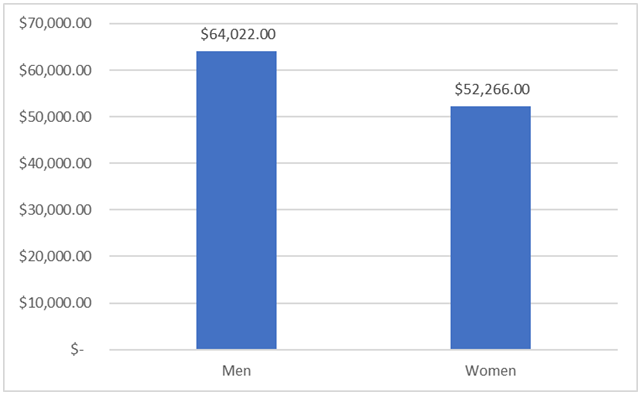Spotlight for Career Services Professionals
Spotlight for Recruiting Professionals
According to the U.S. Bureau of Labor Statistics (BLS), overall, women earn approximately 82% of what their male counterparts do. Results from NACE’s First Destinations Survey for the Class of 2020 reveal that this gap begins as graduates exit college for the world of work—at the start of their careers.
Recommendations for employers
- Standardize pay; eliminate the discretion to set salaries for new hires.
- Conduct an annual pay-equity analysis to determine if there are differentials based on gender and race/ethnicity. Challenge those that correlate to gender or race/ethnicity.
The data show that women with newly minted bachelor’s degrees earn an average of $52,266, compared to $64,022 earned by men, mirroring the overall differential in pay between men and women reported by BLS. (See Figure 1.)
The results dispel the myth that the gender pay gap results from women prioritizing family over career and thus begins later. The disparity is detailed in Gender and Pay Inequity, a special brief based on the Class of 2020 data.
The brief also addresses the myth that differences in academic majors explain the pay gap. First, considering academic major in isolation accounts for some, but not all, of the difference.
Second, there is some evidence that gender bias may account for why some majors have higher salaries. For example, STEM majors generally account for the highest starting salaries, with one exception: biological and biomedical sciences. This is the one STEM discipline where women account for a larger percentage of those earning a bachelor’s degree than men. It is also the lowest paying of the STEM disciplines, with an average starting salary of $39,314 compared to the average of $66,985 for the other STEM disciplines. Do women choose to go into low-paying fields or are the fields low paying because women dominate them? Considering that academic major alone does not account for the difference in pay, a compelling case can be made that gender discrimination underlies the gap.
Figure 1: Average starting salary by gender

Average starting salary for bachelor’s degree graduates from the Class of 2020. Source: NACE Brief: Gender and Pay Inequity, National Association of Colleges and Employers.
Gender and Pay Inequity is based on results from the Class of 2020 first destinations survey. The report, First Destinations for the College Class of 2020, is available on NACEWeb; free to the public, the report includes an executive summary, two special briefs and an interactive dashboard.
This is the seventh first-destination report in a series that began with the college Class of 2014. The survey for the Class of 2020 was conducted through individual colleges and universities nationwide, which then reported their results to NACE. The schools conducted the survey from graduation through December 30, 2020, and reported their data to NACE from January 6 through April 30, 2021. All data in the report are as of December 30, 2020. In total, NACE received reports from 342 schools; they reported outcomes for graduating classes totaling more than 757,000 students in four degree programs—associate, bachelor’s, master’s, and doctoral-level programs. Results for previous classes can also be accessed on the NACE website.





